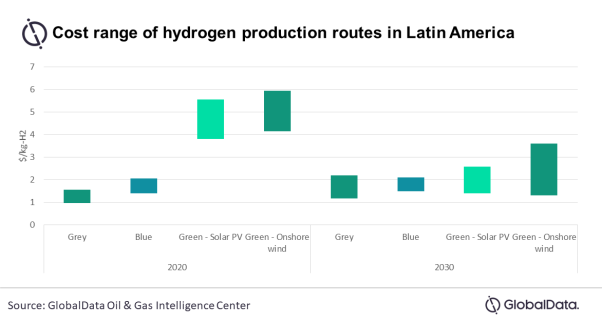The Latin America and the Caribbean (LAC) region is well positioned to participate in the burgeoning hydrogen market, which will play an important role in the coming decades in the global transition to greener energy, according to GlobaData, a leading data and analytics company.
GlobalData’s latest report, ‘Latin America and the Caribbean Hydrogen Market’, notes that an abundance of renewable and biomass resources in the LAC region could allow for low-cost green hydrogen production, with Chile expected to produce the world’s cheapest green hydrogen in its southern regions by 2030. The report highlights that the main barrier to the development of a low-carbon hydrogen supply chain in the LAC region would be establishing an effective policy environment.
Miles Weinstein, Energy Transition Analyst at GlobalData, commented: “Policy and funding could be a challenge for some countries in the LAC region. Ideally, each country would provide incentives for decarbonization and facilitate a build-up of hydrogen infrastructure. This effort could be helped by a stable political environment, as different administrations may have different priorities. Ultimately, the financial health of governments and national oil companies may prove to be a deciding factor as to whether hydrogen plans are followed.”

Traditional ‘grey’ hydrogen is produced using natural gas. Low-carbon production can be achieved by implementing carbon capture technology known as ‘blue’ hydrogen – or by using renewable sources, ‘green’ hydrogen. Today, low-carbon hydrogen production routes around the world remain more expensive than grey hydrogen. However, by 2030, certain regions of LAC could produce green hydrogen at costs competitive to grey hydrogen.
Interest in developing a hydrogen supply chain in the LAC region has been made apparent by a growing number of recent announced projects, partnerships and plans. More than 25 low-carbon hydrogen projects have entered the pipeline in recent years, compared to just three small-scale active projects. This year saw four industry partnerships in the region, more than any previous year. Further, governments are taking note of the opportunity, with Chile releasing a national hydrogen strategy in 2020, with Colombia expected to release one in 2021, and Argentina, Brazil, Uruguay and several others currently drafting theirs.
Weinstein continues: “Of the countries that have released national hydrogen plans, the majority are looking to satisfy domestic demand using blue or green hydrogen in the short term, before expanding production for international export markets in Asia, Europe and North America by around 2030.”
Several LAC countries already have low-carbon-intensity electricity, mainly from hydropower resources. For example, Paraguay produces all of its electricity from hydropower, and often exports excess production. Meanwhile, Costa Rica, Brazil, Uruguay and Colombia also have very high proportions of clean power generation capacity.
Weinstein adds: “Because they already use clean electricity, Paraguay, Costa Rica, Brazil, Uruguay and Colombia could feasibly begin producing green hydrogen in the near term. Others such as Chile and Argentina have untapped promise due to their excellent wind and solar resources, and, in the case of Chile, ambitious decarbonization plans. These will likely expand the renewable portion of their energy mix in the future.”

